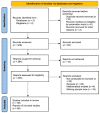Glioma-Associated Microglia Characterization in the Glioblastoma Microenvironment through a 'Seed-and Soil' Approach: A Systematic Review
- PMID: 35741603
- PMCID: PMC9220868
- DOI: 10.3390/brainsci12060718
Glioma-Associated Microglia Characterization in the Glioblastoma Microenvironment through a 'Seed-and Soil' Approach: A Systematic Review
Abstract
Background and aim: Ever since the discovery of tumor-associated immune cells, there has been growing interest in the understanding of the mechanisms underlying the crosstalk between these cells and tumor cells. A "seed and soil" approach has been recently introduced to describe the glioblastoma (GBM) landscape: tumor microenvironments act as fertile "soil" and interact with the "seed" (glial and stem cells compartment). In the following article, we provide a systematic review of the current evidence pertaining to the characterization of glioma-associated macrophages and microglia (GAMs) and microglia and macrophage cells in the glioma tumor microenvironment (TME). Methods: An online literature search was launched on PubMed Medline and Scopus using the following research string: "((Glioma associated macrophages OR GAM OR Microglia) AND (glioblastoma tumor microenvironment OR TME))". The last search for articles pertinent to the topic was conducted in February 2022. Results: The search of the literature yielded a total of 349 results. A total of 235 studies were found to be relevant to our research question and were assessed for eligibility. Upon a full-text review, 58 articles were included in the review. The reviewed papers were further divided into three categories based on their focus: (1) Microglia maintenance of immunological homeostasis and protection against autoimmunity; (2) Microglia crosstalk with dedifferentiated and stem-like glioblastoma cells; (3) Microglia migratory behavior and its activation pattern. Conclusions: Aggressive growth, inevitable recurrence, and scarce response to immunotherapies are driving the necessity to focus on the GBM TME from a different perspective to possibly disentangle its role as a fertile 'soil' for tumor progression and identify within it feasible therapeutic targets. Against this background, our systematic review confirmed microglia to play a paramount role in promoting GBM progression and relapse after treatments. The correct and extensive understanding of microglia-glioma crosstalk could help in understanding the physiopathology of this complex disease, possibly opening scenarios for improvement of treatments.
Keywords: PD-L1; glioblastoma; glioma-associated microglia; immunological homeostasis; tumor microenvironment.
Conflict of interest statement
The authors declare no conflict of interest.
Figures
References
-
- Prosniak M., Harshyne L.A., Andrews D.W., Kenyon L., Bedelbaeva K., Apanasovich T.V., Heber-Katz E., Curtis M.T., Cotzia P., Hooper D. Glioma Grade Is Associated with the Accumulation and Activity of Cells Bearing M2 Monocyte Markers. Clin. Cancer Res. 2013;19:3776–3786. doi: 10.1158/1078-0432.CCR-12-1940. - DOI - PubMed
-
- Zeiner P.S., Preusse C., Blank A.-E., Zachskorn C., Baumgarten P., Caspary L., Braczynski A.K., Weissenberger J., Bratzke H., Reiß S., et al. MIF Receptor CD74 is Restricted to Microglia/Macrophages, Associated with a M1-Polarized Immune Milieu and Prolonged Patient Survival in Gliomas. Brain Pathol. 2014;25:491–504. doi: 10.1111/bpa.12194. - DOI - PMC - PubMed
Publication types
LinkOut - more resources
Full Text Sources
Research Materials



